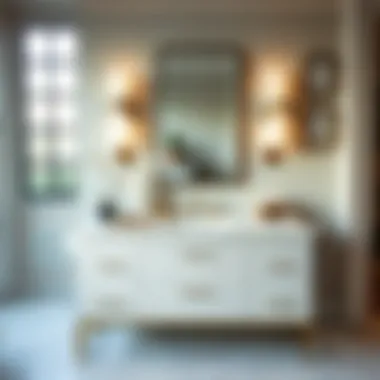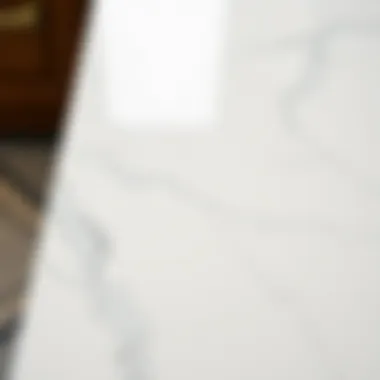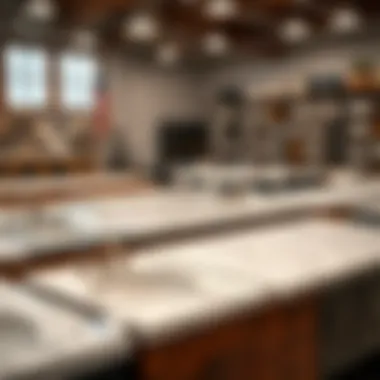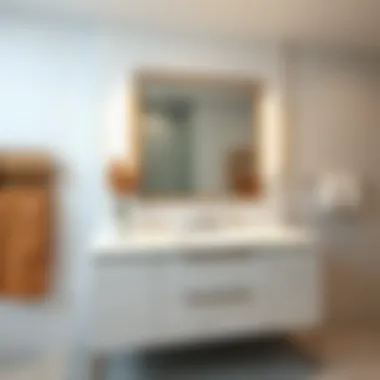Marble Vanity Tops at Home Depot: Key Insights


Intro
When you're thinking about remodeling your bathroom or updating a tired space, the surface of your vanity can make a world of difference. Marble vanity tops have captured the attention of many homeowners and designers alike, creating a buzz with their blend of elegance and sophistication. However, diving into the realm of marble doesn't just mean picking the most beautiful slab. There are practical factors to consider that can impact both the aesthetics and functionality of your vanity. This guide aims to navigate you through the world of marble vanity tops available at Home Depot, covering design trends, essential buying tips, and insights for maintenance. Each step of your journey to the ideal vanity will be highlighted, ensuring you're equipped with the knowledge to make not just a choice, but a well-informed decision.
Design Trends
Current Trends in Vanity Top Styles
Marble has long been a go-to for those wanting to add a touch of luxury to their interiors. Today’s design landscape features a range of colors and finishes, from the classic white Carrara to the deep, rich veining of Calacatta. Homeowners are increasingly embracing unique hues and textures, often opting for something that stands out rather than blends in.
- Bold Colors: Shades like deep greens or navy blue are becoming increasingly common. These rich colors can create a striking contrast with light-colored cabinetry.
- Textured Finishes: While polished marble continues to reign supreme, finishes that showcase the natural veins and patterns in the stone are on the rise. This approach brings out the organic beauty of marble, turning each piece into a work of art.
- Integrated Sinks: Designers are gravitating toward seamless designs where the sink is integrated into the vanity top itself, lending a clean, modern look.
How to Incorporate Trends into Your Space
To seamlessly weave these trends into your home, consider the following strategies:
- Mix and Match: Pair a bold-colored marble with neutral cabinetry to allow it to become the focal point.
- Accent Pieces: For a subtle nod to trends, you could use marble accessories or fixtures that complement the vanity top.
- Consider the Scale: If your bathroom is small, opting for lighter shades of marble may help in making the space feel bigger. Conversely, a large master bath can handle deeper tones and heavier textures.
Buying Guides
Choosing the Right Marble for Your Home
Selecting the right marble can be overwhelming, given the myriad of choices out there. Here are some important factors to keep in mind:
- Purpose of the Space: In high-traffic bathrooms, durability becomes key. Look for options with better resistance to stains and scratches.
- Finish Type: The finish you choose will affect not just the appearance but also the maintenance. Polished marble looks stunning but may show stains more readily.
- Weight Considerations: Marble is heavy, and ensuring your cabinetry can support the weight is crucial. A sturdy base will help prevent future complications.
Tips for Assessing Quality and Value
When shopping at Home Depot, or even elsewhere, here are some pointers:
- Check the Thickness: A thicker slab usually indicates better quality.
- Look for Imperfections: While natural stone often contains some flaws, excessive chipping or uneven surfaces can diminish the appeal.
- Research Brands: Knowing the reputation of different brands available, like MSI or Daltile, can steer you towards high-quality options.
"Choosing a marble vanity top isn't merely a purchase; it's an investment in your home and your personal aesthetic."
By keeping these factors in mind, you can effectively weigh your options and select a marble vanity top that enhances your personal aesthetic while ensuring longevity and functionality. They can truly elevate the design of your space, reflecting a blend of beauty and practicality.
Understanding Marble Vanity Tops
When it comes to enhancing the allure of a bathroom or a powder room, marble vanity tops hold an unparalleled status. Their opulence lies not only in their appearance but also in their capacity to elevate any space with natural elegance. A thorough understanding of marble vanity tops is essential for homeowners, designers, and DIY enthusiasts alike, as it deepens the appreciation of the material’s unique qualities and potential.
Definition and Composition
Marble, a metamorphic rock born from limestone, is primarily composed of calcite, making it a crystalline form of calcium carbonate. Due to geological processes over millions of years, this material takes on striking colors and veining patterns, giving each slab its unique charm. When we talk about marble vanity tops, we are essentially discussing a polished, refined surface of this rock, cut into slabs suitable for bathroom installations.
One of the key features of marble is its porous nature, which can greatly influence its usability in spaces like bathrooms. The natural beauty of marble comes from its original formation, which indicates that no two pieces will look the same. This translates to an aesthetic that’s both distinctive and personalized.
Understanding its composition helps in recognizing why marble behaves the way it does—excellent in durability yet sensitive to certain substances, therefore demanding respect in maintenance. This knowledge will equip you with the insight needed to weigh the pros and cons of selecting marble as your go-to material for vanity tops.
Common Types of Marble Used
Among the wide array of marble types available for vanity tops, a select few consistently stand out due to their aesthetic appeal and practical properties. Here are some of the most commonly used varieties:
- Carrara Marble: Originating in Italy, Carrara is renowned for its classic white or blue-grey hue with subtle veining. It is often a preferred choice for a timeless look, making it popular among many homeowners.
- Calacatta Marble: This type is strikingly luxurious, featuring bold veining patterns on a white background. Calacatta is often associated with high-end designs and can easily serve as a centerpiece in a bathroom.
- Nero Marquina: Characterized by its deep black base with white veining, this marble is perfect for creating dramatic contrasts in a space. It's an excellent option for modern or contemporary designs.
- Statuario Marble: Another Italian contender, Statuario is known for its luminous white surface with prominent grey veining. It combines elegance and sophistication, capturing attention effortlessly.
Selecting the right type of marble not only impacts aesthetics but also involves considerations like weight, cost, and maintenance needs. Knowing the types available empowers homeowners and designers to make thoughtful decisions, ensuring the marble vanity top aligns with both practical requirements and design aspirations.
"Choosing marble is not just about making a surface pretty, it's about embracing its story and making it part of yours."
The Aesthetic Appeal of Marble
When it comes to selecting materials for your home, the visual impact is often at the forefront of decision-making. Marble vanity tops, with their unique textures and colors, can transform an ordinary bathroom into an extraordinary space. The beauty lies not just in their looks but in the way they can enhance the overall ambiance of a room. Choosing marble goes beyond functionality; it is about creating an atmosphere that reflects your personal taste and style.
Natural Beauty and Variability
Marble is a product of nature, and this natural origin is what gives it a complexity that is hard to replicate with synthetic materials. Each slab carries its own geological history, presenting a rich tapestry of colors and veining patterns. From classic white Carrara to the deep greens of Alpi, marble offers a spectrum of choices encouraging homeowners to think creatively. This natural variability means that no two marble surfaces are alike, making your choice distinctly personal.
Additionally, the interplay of light on the polished surface enhances its visual appeal, creating a dynamic look that changes with different lighting conditions. Natural stone has a depth that synthetic finishes simply can’t compete with; the dappled shades and unique marks tell a story of ancient formations.
"Embracing the natural variability of marble means celebrating its imperfections, which can add character and uniqueness to your design."
Integrating Marble into Various Design Styles


One of the remarkable attributes of marble is its versatility in design. It can serve as a striking centerpiece in a modern bathroom, complementing minimalistic aesthetics with its sleek appearance. For a more traditional setting, a rich brown or dark green marble can evoke a sense of luxury and history, grounding the space with its earthy tones.
Moreover, marble easily pairs with countless materials, enabling you to play around with textures. Combine it with wood for a cozy rustic feel or with metal fixtures for a sleek contemporary vibe. Here are some ways to integrate marble:
- Modern Design: Use a pure white marble top with simple, understated cabinetry. Add glass or metal accents for a polished look that feels fresh and airy.
- Traditional Design: Choose a darker marble that harmonizes with stained wood. This can create a rich, warm atmosphere, particularly effective in larger, well-lit bathrooms.
- Eclectic Designs: Embrace the unique properties of marble by combining distinct colors and patterns that catch the eye without clashing.
As you consider the aesthetic qualities of marble, weigh its adaptability against your personal style. Whether your vision is contemporary, traditional, or somewhere in-between, marble has much to offer, elevating your spaces beyond mere function.
Advantages of Marble Vanity Tops
When considering a vanity top, homeowners and designers often look beyond aesthetics. The advantages of marble vanity tops stand testament to their blend of beauty and pragmatism. Marble not only elevates the decor but also boasts functionalities that cater to various lifestyles. Understanding these advantages can significantly aid in decision-making, ensuring that the right choice is made, one that resonates with both style and durability.
Durability and Longevity
Marble is renowned for its robustness. This natural stone, formed over thousands of years through geological processes, exhibits remarkable strength and can last a lifetime without significant wear and tear. A bathroom vanity sees daily use, often being subjected to spills and humidity. Marble's innate durability makes it a fitting choice for these environments.
However, it’s worth noting that like a well-kept secret, marble’s strength comes with its own maintenance quirks. While it can withstand quite a bit, prolonged exposure to acidic substances like lemon juice or vinegar can weaken its surface and potentially stain it. Therefore, diligent care is essential. Ensuring that marble is properly sealed and applying protective measures can extend its life far beyond mere aesthetics.
Additionally, it garners a timeless appeal. Homeowners seeking long-term solutions will find solace in marble's capability to endure both use and trends. Variability in color patterns also means that no two pieces are identical, adding an element of uniqueness to every project. The heft of a marble vanity top can bring a feeling of stability and permanence to any space, an essential factor when creating an inviting atmosphere.
"A well-chosen marble vanity is not just a surface; it can be a centerpiece, echoing the elegance of a bygone era while still serving modern needs."
Heat Resistance and Functionality
Another notable advantage of marble vanity tops is their impressive heat resistance. Specifically, marble can handle high temperatures without noticeable damage, a valuable trait for a bathroom environment. This means that placing hot items, such as a hair straightener or heated towels, directly on its surface won't leave behind unsightly marks or blemishes. As any home decorator knows, maintaining a pristine look is half the battle.
Functionality extends beyond just tolerating heat; its smooth and cool surface offers convenience during daily routines. When applying products or doing makeup, the tactile nature of marble makes the process enjoyable rather than a chore. The stone's ability to remain at a lower temperature compared to other materials adds another layer of comfort during summer months, ensuring that the vanity stays cool to the touch.
Challenges of Marble Vanity Tops
When it comes to choosing materials for vanity tops, marble is a luxurious option that adds elegance and sophistication to any bathrrom. However, homeowners and designers must navigate several challenges involved in owning such a beautiful surface. It’s crucial to understand these obstacles not simply as downsides but as considerations that will ultimately help make informed decisions. This part of the article digs into two major challenges: susceptibility to staining and maintenance requirements.
Susceptibility to Staining
One of the more significant challenges with marble vanity tops is their tendency to stain. While marble is indeed a stunning natural stone, it is also porous. This means it can absorb liquids and substances, which can lead to discoloration over time. Think about it like a sponge. If you spill red wine or leave a splash of your favorite scented lotion on a marble surface, it’s often not just a matter of wiping it up quickly. The absorption can leave behind a mark, especially if the liquid sits for too long.
"Like a thief in the night, some stains sneak up on you when you least expect it."
To mitigate this issue, one can apply a high-quality sealant. It should be understood that while sealing can help prevent stains, it’s not a foolproof solution. Regular maintenance is necessary. Homeowners may find themselves needing to reseal the marble every six months to a year, depending on usage and conditions in their bathroom.
Additionally, some spills require immediate attention. For instance, acidic substances like vinegar, lemon juice, or even some cleaning agents can etch the marble if left unattended. To keep your marble looking its best, adopt the habit of being vigilant and aware of potential hazards.
Maintenance Requirements
Marble has a reputation for being high-maintenance, and this is an accurate description that homeowners should not overlook. Unlike other countertop materials that can be wiped clean without a thought, marble requires a bit more tenderness. Regular cleaning involves using pH-neutral cleaners specifically designed for natural stones. Harsh chemicals can diminish the beautiful finish and even contribute to staining over time.
To ensure longevity, develop a cleaning routine that includes:
- Regular wiping with a soft cloth and gentle cleaner.
- Spot cleaning for immediate response to spills.
- Periodic deep cleaning to assess and maintain the surface's integrity.
Moreover, consider the use of coasters and mats. While it may seem trivial, simple protective barriers can save a lot of hassle. Investing time and effort into maintenance can greatly enhance the life of your marble vanity while sustaining its stunning aesthetics.
In summary, the challenges of marble vanity tops, particularly concerning staining risk and maintenance requirements, demand attention from prospective buyers. By understanding these factors and implementing proper care techniques, homeowners can enjoy the timeless beauty of marble for years to come.
Selecting the Right Marble Vanity Top
When it comes to choosing the ideal marble vanity top, there’s more at stake than merely aesthetics. This decision can significantly impact the charm of your bathroom or powder room. It’s a decision that intertwines functionality, style, and personal taste, making it all the more crucial. With a plethora of options available, understanding the nuances of fit, color, pattern, and finish can elevate the overall experience of your space.
Size and Dimensions Considerations
The size of your vanity top can make or break the visual balance of your bathroom. Marble, being a heavy material, needs to fit snugly on the vanity base without overhangs that can be unsightly or, worse yet, dangerous.
- Measuring Properly: Before you dive headfirst into your selection, take some time to measure the vanity. An accurate measurement ensures that your new top provides the right coverage. Remember, chintzy measurements can lead to costly missteps.
- Standard Sizes vs. Custom Options: While many retailers, including Home Depot, offer standard size marble tops, there’s also the possibility of custom cuts. If your vanity has an unusual shape or size, custom fabrication might just be what you need. This choice also allows for unique design flair, which can enhance your bathroom's personality.
- Thickness Matters: The thickness of the marble isn’t just a matter of preference; it’s also a consideration of strength. Standard vanity tops typically range from 1 to 2 centimeters thick. Thicker options can often stand the test of time better, but they may also weigh more. Ensure your vanity base can support the top's weight without any wobbling issues.
In sum, approaching size and dimensions with precision takes your selection from guesswork to assurance, laying a strong foundation for your vanity.
Color and Pattern Selection
Choosing the right color and pattern for your marble vanity top is akin to picking the right paint for an artist’s canvas. The wrong colors can clash with your existing décor, while the right ones can begin a harmonious relationship in design.
- Understanding Your Space: Consider the overall design of your bathroom. If it boasts bright, airy walls, you might want a marble pattern that complements rather than competes. Neutral tones, such as soft whites and greys, can offer flexibility, whereas bolder colors can act as a statement piece. Think of them as conversations in color; some stay casual, while others demand attention.
- Veining Variations: Marble is well-known for its unique veining, which can vary wildly even within the same type. Some veining is subtle and delicate, whereas others are bold and dramatic. Selecting a piece that matches your style can help create the atmosphere you desire. Checking samples in natural light is crucial; they can look different when the sun hits them.
- Maintaining Longevity: Light colors might show stains more readily than darker shades. If you foresee heavy usage or are often entertained, darker hues could be a smarter choice. On the flip side, lighter marbles can impart a clean, expansive feel to a smaller space.
As you weigh color and pattern options, remember that this isn’t merely about visual appeal. It’s a blend of personal expression and practical considerations that can elevate your bathroom from ordinary to extraordinary.


"Selecting a marble vanity top is not just a decision—it's the beginning of an artistic journey within your home."
Installation Options for Marble Vanity Tops
When it comes to installing marble vanity tops, the approach can make all the difference. The choice between professional installation and do-it-yourself (DIY) methods can impact not only the final look but also the durability and performance of the vanity top. Understanding these options is crucial for homeowners, designers, and enthusiasts looking to achieve a seamless integration of their chosen marble into their space.
Professional Installation vs. DIY
Opting for professional installation is often the safer path, especially when it comes to heavy materials like marble. Experts in the field understand the nuances of handling the stone, ensuring it is positioned correctly to avoid any undue stress that can lead to cracking or chipping. Furthermore, professionals are well-versed in the specific requirements for securing the vanity top to the cabinetry, ensuring a secure fit. This can be particularly important if the marble has intricate patterns that need to align perfectly.
On the other hand, the DIY route provides a sense of accomplishment and may save some cash. With the right tools and a bit of patience, individuals can tackle the installation themselves. That said, it’s vital to recognize the challenges involved. Mistakes in measuring or cutting can be costly, both in terms of materials and time.
Deciding between these options often boils down to one’s skill level and willingness to invest either time or money. Sometimes, it may even be worth considering a hybrid approach—handling some aspects of the installation oneself while leaving the more complex tasks to a professional.
Consider the following factors when deciding on installation method:
- Skill level in working with heavy materials
- Budget allocated for installation
- Time availability for DIY projects
- Access to necessary tools and equipment
Necessary Tools for Installation
Should you choose to embark on the DIY path, being equipped with the right tools is essential. Here’s a rundown of the items you’ll likely need:
- Measuring Tape: Precision is key, especially when dealing with stone.
- Level: Ensuring that the vanity top sits perfectly level will enhance both appearance and function.
- Caulk Gun: Useful for applying adhesive securely, ensuring the marble stays in place without gaps.
- Power Drill: Handy for making any necessary adjustments or drilling into cabinetry if securing brackets.
- Saw for Cutting Stone: If adjustments to size are necessary, a wet saw specifically made for cutting tile and stone can be invaluable.
- Sponge and Water: Keeping your workspace clean is vital for safety and efficiency; water helps with the cutting process too.
Having these tools at your disposal minimizes the likelihood of error and makes for a smoother installation process. However, if you're uncertain or find yourself hesitating, consulting with a professional can save you the headache of correction later down the line.
With the proper approach, whether through professional help or a DIY endeavor, the result can turn any bathroom into a sophisticated oasis, delighting homeowners and guests alike.
Cost Considerations
Understanding the cost considerations behind marble vanity tops is fundamental. When homeowners and designers decide on materials for their spaces, the budget plays a significant role. Marble is often renowned for its beauty, but the financial implications can be equally important. Balancing quality and affordability helps in making sound decisions, ensuring that the chosen material not only enhances aesthetics but also aligns with spending limits.
Price Range of Marble Vanity Tops at Home Depot
The price of marble vanity tops at Home Depot can vary considerably, influenced by factors such as origin, quality, and design complexity. Typically, you might expect to find prices ranging from $300 to $2,000 depending on the specific attributes. For instance, a standard white Carrara marble top might cost around $500, while more intricate designs with exotic patterns can push the price upwards.
Here are some insights to consider when looking at the price:
- Material Origin: Marble sourced from different regions can vary in price. Italian marble, known for its quality, often commands a higher price.
- Thickness and Size: Thicker slabs might exhibit much higher prices due to the additional material and processing required.
- Custom Designs: If you’re leaning towards a custom design, keep in mind that this will incur additional costs due to precision cutting and installation.
This range gives a basic idea, but the total expenses might sway based on the choice of accessories, like undermount sinks or decorative edges.
Budgeting for Installation
Proper budgeting for installation is crucial. Installation costs should not be an afterthought. While a marble vanity top can significantly elevate a bathroom's elegance, the labor necessary to fit it securely and correctly can add substantially to the overall price.
Here are some elements to take into account while planning your budget:
- Professional Installation: Hiring experts typically averages around $200 to $500, depending on your geographical location and the complexity of the job. Experience counts here, as a sturdily installed top can save future headaches.
- DIY Installation: If you consider a DIY approach, you’ll need tools such as a wet saw and adhesive, and perhaps some guidance from online tutorials or manuals. This can save money but requires effort and skill.
- Hidden Costs: Don't forget about potential hidden costs like disposal of old materials or additional reinforcement needed for cabinets.
"A well-planned budget not only safeguards against overspending but can also lead to unexpected finds, ensuring that every penny is wisely invested.”
Taking these considerations to heart will ensure that your investment in a marble vanity top is not just an aesthetic choice, but a financially sound one too. The right balance of cost and quality can help create a lasting impact.
Maintenance and Care for Marble Vanity Tops
Caring for marble vanity tops is akin to nurturing a fine plant; it requires attention and knowledge to keep it thriving. Understanding the significance of maintaining these surfaces is crucial for homeowners, designers, and DIY enthusiasts alike. Marble, with its stunning aesthetics, can become a focal point in bathrooms or kitchens, but only if it is treated with the respect it deserves. Regular maintenance not only preserves its beauty but also extends its lifespan, making it a sound investment for any space.
One cannot overlook the fact that marble is a natural stone. This characteristic gives it unique coloration and patterns, but it also means the material is porous and can be susceptible to stains and scratches. Implementing a consistent cleaning and seal routine is vital to protect the surface from daily wear and tear. By prioritizing maintenance, you'll ensure that your marble vanity top remains a beacon of elegance for years to come.
Regular Cleaning Routines
Establishing a cleaning regimen for your marble vanity is straightforward, yet it may require some specific practices to preserve its integrity. Think of it as ensuring a delicate balance; improper cleaning can cause more harm than good. Here are several key points to consider:
- Use pH-neutral cleaners: Strong acids or harsh chemicals can etch and dull the surface. Liquid dish soap mixed with water is often a safe bet.
- Soft cloths are your best friends: Avoid abrasive materials like steel wool or rough sponges, as these can scratch the surface. A microfiber cloth does wonders to capture dirt without scratching.
- Wipe up spills immediately: Marble is prone to staining, so it’s wise to address spills like wine or toiletries without delay. The quicker you act, the less likelihood of a permanent mark.
- Frequent dusting: Dust particles can slowly wear down the finish over time. A quick wipe-down with a dry soft cloth every few days can keep the surface looking spick and span.
By incorporating these practices into your cleaning routines, you’ll not only maintain that high-gloss sheen but also promote longevity. Regularity is key—think of it not as a chore, but as part of your daily or weekly self-care ritual for a very fine material.
Sealing and Protection Products
Sealing is an often-overlooked aspect of marble maintenance. A good-quality sealer is like an insurance policy for your vanity top, safeguarding it against stains and wear. While the frequency of sealing may depend on your specific environment (a high-traffic bathroom may require more attention than a rarely used powder room), it is generally recommended to seal the surface at least once a year.
When selecting a sealer, keep these factors in mind:


- Type of sealer: There are impregnating sealers, which penetrate deeply into the stone, and topical sealers, which sit on the surface. Each has its advantages depending on your specific needs.
- Application process: Sealing is not overly complex, but doing the job right can make a significant difference. Make sure the surface is clean and dry before application. Use an applicator pad and follow the product instructions for best results.
- Protection against heat: While marble handles heat better than many materials, it’s still wise to use coasters or trivets. A sealer can help protect against any potential damage from hot items.
Using the appropriate sealing products and following the recommended guidelines will provide an additional layer of protection and ensure that your marble vanity top stays rich and vibrant for many seasons.
"A little proactive care goes a long way in preserving the luxury and integrity of marble surfaces."
Maintaining marble vanity tops involves vigilance, but the rewards are profound. Proper cleaning routines and timely sealing not only keep your surfaces looking beautiful but also empower the homeowner to make a statement in their design choices. Therefore, dedicating the necessary effort into marble maintenance ultimately pays off in elegance and function.
Trends in Marble Vanity Tops
The world of design is not stagnant; it’s an ever-evolving landscape where trends shift like sand under the tide. When it comes to marble vanity tops, homeowners and designers alike find that staying attuned to current trends can significantly enhance their overall aesthetic and functionality. Not only do these trends reflect changing design philosophies, but they also offer insight into how materials are utilized in contemporary spaces.
Understanding the trends in marble vanity tops is essential for making selections that are not just attractive but also timeless. The marriage of durability and style makes marble a go-to choice for many. Each trend can inspire unique approaches to integrating marble into your home, whether you’re renovating a bathroom or constructing a new space entirely.
Contemporary Designs
Contemporary design embraces simplicity and the beauty of minimalism while highlighting the raw charm of natural materials. In the realm of marble vanity tops, designers are increasingly leaning toward streamlined shapes and understated elegance. Rounded edges and sleek, rectangular silhouettes are favored for their clean lines, which seamlessly blend into modern bathroom designs.
Moreover, the finish of marble surfaces plays a vital role in contemporary aesthetics. A polished finish dazzles under bright LED lighting, creating a luxurious gleam that draws the eye. On the other hand, honed or matte finishes have gained traction for their softer, organic feel. This type of finish not only minimizes glare but also provides a tactile experience that many homeowners appreciate.
One contemporary approach is pairing marble vanity tops with contrasting materials like wood or metal. This mix-and-match style creates a dynamic intersection of textures, imbuing the bathroom with character. Imagine a white Carrara marble top against a reclaimed wooden vanity or dark cabinetry—such combinations can create a stunning focal point that captures attention.
Color Trends and Innovations
The color palette of marble has expanded in recent years, moving beyond the traditional whites and creams. Homeowners are now favoring bolder hues and unique patterns. Deep blues, rich greens, and various veining styles are being introduced into the market, offering more personalization than ever before.
Furthermore, innovations in technology have paved the way for engineered marble, which mirrors the looks of natural stone while providing greater consistency in pattern and color. These advances allow consumers to attain specific looks that might not be achievable with traditional marble.
Homeowners are also exploring two-toned vanity tops, where contrasting colors or finishes merge to create distinctive, eye-catching designs. This trend allows individuals to express their personal style while still benefiting from marble's elegance and durability.
"Trends in marble vanity tops not only reflect changing tastes but also open up avenues for creative expression in home design."
Comparative Analysis: Marble vs. Other Materials
When it comes to selecting vanity tops, the variety of materials can be dizzying—each with its own pros and cons. This section critically analyzes marble in comparison to popular alternatives like granite and quartz, providing insights that can help homeowners and designers make informed choices. Understanding the differences in aesthetics, durability, and maintenance can significantly impact how a space feels and functions.
Comparing with Granite and Quartz
Granite, usually a top competitor for marble, boasts its own allure. It’s well-known for being hard as nails, which means it stands resilient against scratches and chips. However, there’s more to this stone than just its durability. Granite's patterns are predominantly flecked, often creating a rugged visual that warms up a room but can lack the fine, veined elegance of marble. Unlike marble, which offers a variety of striking colors from creams to deep greens and rich pinks, granite often sticks to earth tones.
On the other hand, quartz, an engineered product, presents some unique benefits. Its non-porous surface is a practical choice for busy bathrooms, since it’s resistant to stains and bacteria—much like Teflon cookware. Yet, granite and marble fans might argue that quartz lacks the charm of natural stone. **The beauty of quartz lies in its uniformity; suitable for a minimalist look but perhaps too predictable for someone looking to make a statement.
When comparing their costs,
- Marble typically lands in the mid to high price range, depending on quality and rarity.
- Granite may be cheaper per square foot, especially for common patterns, while higher-end granites can rival marble.
- Quartz, often marketed as a premium product, can vary, sometimes making it more expensive.
Choosing between these materials often boils down to a trade-off between luxury style and practicality. If a homeowner desires that high-end finish, marble definitely shines as the go-to choice, especially for those looking for unique artistry in their stone.
Pros and Cons of Different Materials
In considering marble, granite, and quartz, it’s essential to weigh their advantages and disadvantages. Each material carries specific features that could sway your decision.
Pros of Marble
- Aesthetic Appeal: Marble brings an unmatched elegance, with intricate patterns adding character to any space.
- Heat Resistance: It can endure hot items, making it a functional choice for bold homeowners.
Cons of Marble
- Susceptibility to Stains: Even sealed, it can absorb spills and leave permanent marks.
- High Maintenance: Regular sealing and careful cleaning are essential to maintain its beauty.
Pros of Granite
- Durability: Tougher against scratches and heat than marble.
- Unique Patterns: No two granite slabs are alike, offering a personal touch.
Cons of Granite
- Heavy Weight: Installation requires strong support structures—a consideration for DIYers.
- Limited Color Range: Predominantly earthy tones, may not suit every design.
Pros of Quartz
- Easy Maintenance: Non-porous surfaces resist stains and require less upkeep.
- Variety of Styles: Engineered to replicate any look, from marble to concrete.
Cons of Quartz
- Heat Sensitivity: Can be damaged by excessive heat, a downside in kitchen settings.
- Cost: Often pricier than granite and comparable to marble in high-end finishes.
“The choice of a vanity top isn’t just foundational for your room; it must also reflect your style and how much love you’re willing to give to it. ”
For additional insights into stone materials, one might explore further at sources like Wikipedia, or delve into detailed discussions in forums such as reddit.com. This can greatly enhance the understanding of the long-range benefits and potential drawbacks of each material.















